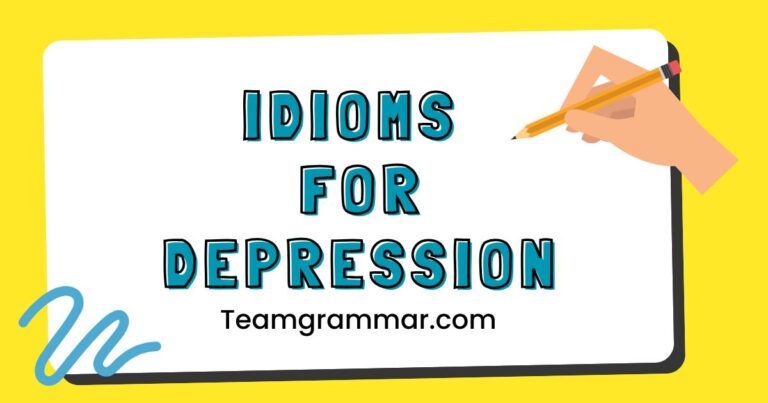25 Idioms for Hope: A Comprehensive Guide
Understanding idioms is crucial for mastering English because they add color and depth to communication. Idioms related to ‘hope’ are especially powerful, reflecting optimism, resilience, and anticipation of positive outcomes.
This article delves into the world of idioms that convey hope, exploring their meanings, origins, and usage. English language learners of all levels will benefit from this comprehensive guide, which provides clear explanations, numerous examples, and practical exercises to enhance their understanding and fluency.
Whether you’re preparing for an English proficiency exam or simply aiming to enrich your vocabulary, this guide will equip you with the knowledge and skills to confidently use idioms of hope in everyday conversations and writing. Through detailed explanations, practical examples, and interactive exercises, you’ll gain a deeper appreciation for the nuances of the English language and the power of hope in communication.
Table of Contents
- Introduction
- Definition of Idioms for Hope
- Structural Breakdown of Idioms
- Types and Categories of Hope Idioms
- Examples of Idioms for Hope
- Usage Rules for Idioms of Hope
- Common Mistakes with Hope Idioms
- Practice Exercises
- Advanced Topics
- FAQ: Frequently Asked Questions
- Conclusion
Definition of Idioms for Hope
An idiom is a phrase or expression whose meaning cannot be understood from the literal meanings of its individual words. Instead, it conveys a figurative or symbolic meaning that is culturally specific.
Idioms related to hope are expressions that encapsulate optimism, anticipation, and the belief in a positive future. These idioms often use vivid imagery and metaphors to convey a sense of encouragement and resilience.
The function of these idioms is to add emotional depth and cultural context to conversations, making them more engaging and relatable. Understanding these idioms requires familiarity with cultural references and linguistic nuances.
Idioms for hope serve not only to express optimistic feelings but also to offer encouragement and motivation in challenging situations. They are frequently used in literature, speeches, and everyday conversations to convey complex emotions concisely.
For instance, the idiom “seeing light at the end of the tunnel” encapsulates the hope of overcoming a difficult period, even when the present circumstances seem bleak. These expressions enhance communication by adding layers of meaning and emotional resonance.
The context in which an idiom is used is critical to its interpretation. The same idiom can have slightly different connotations depending on the speaker’s tone and the surrounding conversation.
Therefore, learning idioms involves not only memorizing their definitions but also understanding their appropriate usage in various scenarios. This contextual awareness is essential for effective communication and avoiding misunderstandings.
Structural Breakdown of Idioms
Idioms, by their nature, defy strict grammatical rules. They are fixed expressions, meaning that the words and their order cannot be altered without changing the idiom’s meaning or rendering it nonsensical.
The structural elements of idioms often involve metaphors, similes, and other figures of speech. Understanding these elements can provide insights into the idiom’s origin and meaning.
Many idioms related to hope contain verbs and nouns that create vivid imagery. For example, “to keep one’s chin up” uses the physical action of lifting one’s chin to symbolize maintaining a positive attitude.
The structure of this idiom is straightforward, but its meaning is deeply rooted in the association between physical posture and emotional state. Similarly, “to look on the bright side” employs the metaphor of brightness to represent optimism.
The structural breakdown involves recognizing the literal components and interpreting their symbolic significance.
The patterns in idioms are often irregular, making it challenging to predict their meaning based on grammatical rules alone. However, some idioms follow common structural patterns, such as using prepositions to create a sense of direction or movement.
For instance, “to hope against hope” uses the preposition “against” to emphasize the persistence of hope even in the face of overwhelming odds. Recognizing these structural nuances can aid in deciphering the meaning of unfamiliar idioms.
Types and Categories of Hope Idioms
Idioms for hope can be categorized based on the specific aspect of hope they convey, such as resilience, optimism, or anticipation. These categories help to organize and understand the nuances of different expressions.
Here are some key types and categories:
Idioms of Resilience
These idioms emphasize the ability to bounce back from adversity and maintain hope in the face of challenges. They often involve metaphors of strength and endurance.
Examples include “to weather the storm,” “to keep the faith,” and “to never say die.” These expressions highlight the importance of perseverance and inner strength in maintaining hope.
Idioms of Optimism
These idioms focus on maintaining a positive outlook and believing in a favorable outcome. They often use imagery of light, brightness, and forward movement.
Examples include “to look on the bright side,” “to see the glass half full,” and “to keep one’s chin up.” These expressions encourage a proactive approach to hope, emphasizing the power of positive thinking.
Idioms of Anticipation
These idioms express the anticipation of a positive future and the expectation of good things to come. They often involve metaphors of looking ahead and preparing for success.
Examples include “to hope for the best,” “to keep one’s fingers crossed,” and “to see light at the end of the tunnel.” These expressions highlight the importance of patience and belief in a brighter future.
Idioms of Encouragement
These idioms are used to inspire hope in others, often in situations of doubt or despair. They frequently involve direct and supportive language.
Examples include “hang in there,” “don’t lose heart,” and “keep your spirits up.” These expressions provide comfort and motivation, reinforcing the importance of hope during difficult times.
Examples of Idioms for Hope
Understanding idioms requires seeing them in context. The following tables provide a variety of examples, categorized by the type of hope they express.
Each example includes the idiom, its meaning, and a sentence illustrating its use.
Table 1: Idioms of Resilience
This table provides examples of idioms that express the ability to bounce back from adversity and maintain hope in the face of challenges. Each idiom is defined and illustrated with a sentence.
| Idiom | Meaning | Example Sentence |
|---|---|---|
| Weather the storm | To survive a difficult period | We’re facing some tough economic times, but we’ll weather the storm. |
| Keep the faith | To maintain belief and hope | Even though things are hard, keep the faith and believe it will get better. |
| Never say die | To refuse to give up | Our team was losing, but we never say die and managed to win. |
| Hold on tight | To persevere through a difficult situation | Hold on tight, this project gets easier once you get through the initial stages. |
| Ride out the storm | To endure a challenge without being harmed | The company had to ride out the storm of bad publicity. |
| Hang tough | To remain determined and resilient | Hang tough, we’re almost at the finish line. |
| Come through with flying colors | To succeed brilliantly despite challenges | She came through the exam with flying colors after weeks of studying. |
| Get through it | To successfully overcome a difficult experience | With the support of her family, she knew she would get through it. |
| Stand tall | To remain confident and strong in the face of adversity | Even though she faced criticism, she stood tall and defended her beliefs. |
| Stay afloat | To manage to survive financially or otherwise | The small business struggled to stay afloat during the recession. |
| Keep your head above water | To manage to survive despite difficulties | With so many bills, it’s hard to keep my head above water. |
| Pull through | To recover from a serious illness or difficulty | The doctors are optimistic that he will pull through. |
| Bounce back | To recover quickly from a setback | After the disappointment, she quickly bounced back and started a new project. |
| Turn the corner | To pass a critical point and begin to improve | The company has finally turned the corner and is starting to make a profit. |
| Rise from the ashes | To emerge stronger after a period of destruction or failure | The city rose from the ashes after the devastating earthquake. |
| Turn a new leaf | To start behaving in a better way | He decided to turn a new leaf and quit his bad habits. |
| Make the best of it | To try to be positive in a difficult situation | We can’t change what happened, so we have to make the best of it. |
| Find strength in adversity | To discover inner resilience during challenging times | She found strength in adversity and emerged as a leader. |
| Keep going | To continue despite difficulties | Even when you feel like giving up, just keep going. |
| Push through | To continue with determination despite obstacles | We have to push through this final stage to complete the project. |
| Cling on | To hold on tightly to hope or a belief | Despite the odds, they clung on to the hope of finding a cure. |
| Bear up | To remain cheerful during a difficult time | She bore up well despite the stress of the situation. |
| Stay strong | To remain resilient and not give in to despair | Stay strong, things will eventually get better. |
Table 2: Idioms of Optimism
This table showcases idioms that focus on maintaining a positive outlook and believing in a favorable outcome. Each idiom is defined and an example sentence is provided.
| Idiom | Meaning | Example Sentence |
|---|---|---|
| Look on the bright side | To focus on the positive aspects of a situation | Even though we lost the game, let’s look on the bright side – we played well. |
| See the glass half full | To be optimistic about a situation | Instead of complaining, try to see the glass half full. |
| Keep one’s chin up | To remain cheerful despite difficulties | Keep your chin up; things will get better soon. |
| Every cloud has a silver lining | There is something good in every bad situation | Even though he lost his job, remember that every cloud has a silver lining. |
| Think positive | To maintain an optimistic mindset | If you want to achieve your goals, you need to think positive. |
| Hope springs eternal | Hope always exists, even in difficult times | Even after so many failures, hope springs eternal in his heart. |
| Paint a rosy picture | To present a situation in an overly optimistic way | The politician painted a rosy picture of the economy to gain support. |
| Brighten someone’s day | To make someone feel happier | A simple compliment can brighten someone’s day. |
| Make sunshine | To bring happiness to others | Her cheerful attitude always helps to make sunshine in the office. |
| See a rainbow after the rain | To find something beautiful after a difficult experience | After overcoming her illness, she felt like she was seeing a rainbow after the rain. |
| Believe in the light | To have faith in a positive future | Even in the darkest times, we must believe in the light. |
| Expect the best | To anticipate a positive outcome | If you expect the best, you’re more likely to achieve it. |
| Have a positive outlook | To maintain an optimistic view of life | Having a positive outlook can help you overcome many challenges. |
| Look forward to | To anticipate something with pleasure | I’m really looking forward to my vacation. |
| See the possibilities | To recognize potential opportunities | Instead of focusing on the problems, try to see the possibilities. |
| Count your blessings | To be grateful for the good things in your life | When you’re feeling down, take time to count your blessings. |
| Keep a song in your heart | To maintain a cheerful and optimistic attitude | Despite her troubles, she always kept a song in her heart. |
| Find the silver lining | To discover something positive in a negative situation | Even in this setback, we can find the silver lining and learn from it. |
| Think of the best | To focus on the most positive outcome | Think of the best possible scenario and work towards it. |
| Have high hopes | To have great expectations for the future | We have high hopes for the success of this project. |
| Be on the up and up | To be improving and becoming more successful | His career has been on the up and up since he joined the new company. |
| See a brighter future | To envision a more positive future | Let’s work together to see a brighter future for our children. |
Table 3: Idioms of Anticipation
This table presents idioms that express the anticipation of a positive future and the expectation of good things to come. Each idiom is defined and an example sentence is provided.
| Idiom | Meaning | Example Sentence |
|---|---|---|
| Hope for the best | To expect a positive outcome | We’ve done everything we can; now we can only hope for the best. |
| Keep one’s fingers crossed | To hope for good luck | I have an interview tomorrow, so keep your fingers crossed for me. |
| See light at the end of the tunnel | To see a positive outcome after a difficult period | After months of hard work, we can finally see light at the end of the tunnel. |
| Look to the future | To think about and plan for what is going to happen in the future | We should look to the future and invest in renewable energy sources. |
| Wait with bated breath | To wait anxiously for something to happen | We waited with bated breath for the election results. |
| Hold out hope | To continue to hope, even when things seem unlikely | The family is still holding out hope that their missing son will be found. |
| Pin one’s hopes on | To rely on something to happen | She is pinning all her hopes on getting accepted into her dream university. |
| Dream of a better tomorrow | To imagine a more positive future | We must dream of a better tomorrow and work towards making it a reality. |
| Have faith in the future | To believe that the future will be positive | We should have faith in the future and invest in sustainable practices. |
| Set one’s sights on | To have a goal and work towards achieving it | He has set his sights on becoming a doctor. |
| Keep the dream alive | To continue to believe in a goal or aspiration | Despite the challenges, we must keep the dream alive. |
| Look to greener pastures | To seek better opportunities in a different place or situation | After years of working at the same company, he decided to look to greener pastures. |
| Await with anticipation | To wait eagerly for something to happen | The children await with anticipation the arrival of Santa Claus. |
| Expect great things | To anticipate significant achievements | We expect great things from our new team member. |
| Look ahead with optimism | To plan for the future with a positive attitude | We should look ahead with optimism and invest in innovative technologies. |
| Trust in divine providence | To believe that a higher power will provide | In times of uncertainty, we must trust in divine providence. |
| Yearn for a brighter future | To long for a more positive future | We all yearn for a brighter future for our children. |
| Envision a positive outcome | To imagine a favorable result | We should envision a positive outcome and work towards making it a reality. |
| See a good omen | To interpret something as a sign of good luck | Finding a four-leaf clover is often seen as a good omen. |
| Wish upon a star | To make a wish in the hope that it will come true | She wished upon a star for her dreams to come true. |
| Have something to look forward to | To have an event or experience that one is eagerly anticipating | Having a vacation planned gives me something to look forward to. |
| Count the days | To eagerly await a future event by tracking the passage of time | The children are counting the days until Christmas. |
Table 4: Idioms of Encouragement
This table lists idioms that are used to inspire hope in others, often in situations of doubt or despair. Each idiom is defined, and its usage is demonstrated with a sentence.
| Idiom | Meaning | Example Sentence |
|---|---|---|
| Hang in there | To persevere and not give up | I know it’s tough, but hang in there; you’ll get through it. |
| Don’t lose heart | To not become discouraged | Don’t lose heart; your efforts will eventually pay off. |
| Keep your spirits up | To remain cheerful and optimistic | Even though things are difficult, try to keep your spirits up. |
| Chin up | To encourage someone to stay positive | Chin up! Things will get better soon. |
| Keep your pecker up | To remain cheerful and optimistic (British English) | Even after the setback, he kept his pecker up and continued to work hard. |
| There’s always light at the end of the tunnel | There is hope even in the most difficult situations | Don’t give up; remember there’s always light at the end of the tunnel. |
| Keep the home fires burning | To maintain hope and warmth during a difficult time | While he was away at war, she kept the home fires burning. |
| Hold the fort | To maintain things as they are until someone returns or a situation changes | Can you hold the fort while I run out to get lunch? |
| Keep a stiff upper lip | To remain brave and not show emotion during a difficult time | Despite the bad news, she kept a stiff upper lip. |
| Keep pushing | To continue to strive towards a goal | Even when things get tough, keep pushing towards your dreams. |
| Don’t give up the ship | To not abandon hope or effort | We’re facing tough challenges, but we must not give up the ship. |
| Keep the faith | To continue to believe in something | Even though it’s been a long journey, we must keep the faith. |
| Stay positive | To maintain an optimistic attitude | No matter what happens, it’s important to stay positive. |
| Look forward | To anticipate with pleasure | Always look forward to the good things in life. |
| Hold on | To persevere through a difficult situation | Just hold on a little longer; things will get better. |
| Carry on | To continue despite difficulties | Despite the setbacks, we must carry on with our work. |
| Take heart | To feel encouraged | Take heart, things will improve soon. |
| Bless your heart | An expression of sympathy and encouragement | You’re going through a tough time; bless your heart. |
| Cheer up | To try to make someone feel happier | Cheer up, tomorrow is a new day. |
| The sun will come out tomorrow | A reminder that difficult times don’t last forever | Don’t worry too much; the sun will come out tomorrow. |
| Keep the ball rolling | To maintain momentum and continue with an activity | Let’s keep the ball rolling and finish this project on time. |
Usage Rules for Idioms of Hope
Using idioms correctly requires attention to context, tone, and audience. Here are some key rules to follow when using idioms of hope:
- Context: Ensure that the idiom is appropriate for the situation and the overall message you are trying to convey.
- Tone: Be mindful of the tone of the conversation. Some idioms are more formal than others and may not be suitable for casual settings.
- Audience: Consider your audience’s familiarity with idioms. Avoid using obscure or culturally specific idioms that they may not understand.
- Accuracy: Use the idiom correctly. Do not alter the words or their order, as this can change the meaning or render the idiom nonsensical.
- Moderation: Use idioms sparingly. Overusing idioms can make your language sound unnatural or forced.
It’s also important to understand the nuances of each idiom. For example, “to keep one’s chin up” is generally used in informal settings to offer encouragement, while “to weather the storm” can be used in more formal contexts to describe resilience in the face of significant challenges.
Paying attention to these subtle differences will enhance your communication skills and avoid misunderstandings.
Common Mistakes with Hope Idioms
One of the most common mistakes is using idioms out of context. For example, saying “Let’s weather the storm” when simply discussing a minor inconvenience is inappropriate.
Another frequent error is altering the words of the idiom, such as saying “look on the bright side of the road” instead of “look on the bright side.” Here are some additional common mistakes:
- Literal Interpretation: Taking the idiom literally instead of understanding its figurative meaning.
- Misunderstanding Cultural References: Failing to grasp the cultural or historical context behind the idiom.
- Using Inappropriate Tone: Employing an idiom that does not match the formality or informality of the situation.
- Overusing Idioms: Making your speech sound unnatural by including too many idioms.
Here are examples of correct and incorrect usage:
| Incorrect | Correct |
|---|---|
| “We will see the light at the end of the road.” | “We will see light at the end of the tunnel.” |
| “Keep your head up high.” | “Keep your chin up.” |
| “Every cloud has a gold lining.” | “Every cloud has a silver lining.” |
Practice Exercises
Test your understanding of idioms for hope with these practice exercises. Fill in the blanks with the appropriate idiom from the list provided.
Idiom List: keep the faith, look on the bright side, weather the storm, keep your chin up, see light at the end of the tunnel, hope for the best, hang in there, never say die, every cloud has a silver lining, pull through
Exercise 1
Complete the sentences using the idioms provided above.
| Question | Answer |
|---|---|
| 1. Even though the project is behind schedule, we need to ________ and finish it. | hang in there |
| 2. Despite the challenges, ________; things will eventually get better. | keep the faith |
| 3. We’re going through a tough time, but we’ll ________. | weather the storm |
| 4. Even though we lost the game, let’s ________. We still have a chance next week. | look on the bright side |
| 5. She’s been ill for a long time, but we’re hoping she’ll ________. | pull through |
| 6. After months of hard work, we can finally ________. | see light at the end of the tunnel |
| 7. We’ve done everything we can; now we can only ________. | hope for the best |
| 8. Our team was losing, but we ________ and managed to win. | never say die |
| 9. He lost his job, but ________; he might find an even better one. | every cloud has a silver lining |
| 10. ________; things will get better soon. | keep your chin up |
Exercise 2
Choose the correct idiom to complete each sentence.
| Question | Answer |
|---|---|
| 1. I know you’re feeling down, but try to ________. (a) see the dark side (b) look on the bright side (c) find the grey area | (b) look on the bright side |
| 2. The company is struggling, but we’re determined to ________. (a) swim against the tide (b) weather the storm (c) float on sunshine | (b) weather the storm |
| 3. Even when things are tough, it’s important to ________. (a) lose faith (b) keep the faith (c) abandon hope | (b) keep the faith |
| 4. We’re facing a difficult challenge, but we ________ and find a solution. (a) never say quit (b) never say die (c) always say try | (b) never say die |
| 5. After a long and difficult project, we can finally ________. (a) see darkness at the end of the tunnel (b) see light at the end of the tunnel (c) see a shadow at the end of the path | (b) see light at the end of the tunnel |
| 6. Don’t ________; things will get better. (a) lower your head (b) drop your spirits (c) lose heart | (c) lose heart |
| 7. We’ve done all we can; now we can only ________. (a) wish for the worst (b) hope for the best (c) expect the minimum | (b) hope for the best |
| 8. ________! You’ll get through this. (a) Hang out there (b) Hang in there (c) Hang around | (b) Hang in there |
| 9. Every challenge is an opportunity; ________. (a) every cloud has a dark lining (b) every cloud has a silver lining (c) every storm has a gold lining | (b) every cloud has a silver lining |
| 10. ________, and things will improve. (a) Keep your head down (b) Keep your chin up (c) Keep your eyes closed | (b) Keep your chin up |
Advanced Topics
For advanced learners, exploring the etymology and cultural context of hope idioms can provide a deeper understanding of their meaning and usage. Researching the origins of idioms like “to keep one’s chin up” can reveal interesting insights into the historical attitudes towards posture and emotional well-being.
Additionally, comparing idioms for hope across different languages can highlight cultural differences in expressing optimism and resilience.
Another advanced topic is the use of idioms in persuasive writing and public speaking. Mastering the art of incorporating idioms effectively can enhance the emotional impact of your message and make it more memorable.
However, it’s crucial to use idioms judiciously and avoid clichés that can weaken your argument. Analyzing speeches and literary works to identify how idioms are used to evoke hope can be a valuable exercise for advanced learners.
Furthermore, exploring the evolution of idioms over time can provide insights into how language reflects societal changes. Some idioms may become obsolete, while others may acquire new meanings or connotations.
Studying these linguistic shifts can deepen your understanding of the dynamic nature of language and its relationship to culture.
FAQ: Frequently Asked Questions
- What is an idiom?
An idiom is a phrase or expression whose meaning cannot be understood from the literal meanings of its individual words. Instead, it conveys a figurative or symbolic meaning that is culturally specific.
- Why is it important to learn idioms?
Learning idioms is crucial for mastering English because they add color and depth to communication. Understanding idioms allows you to comprehend nuanced meanings and communicate more effectively in both spoken and written English. It also helps you to avoid misinterpretations and connect with native speakers on a deeper level.
- How can I improve my understanding of idioms?
To improve your understanding of idioms, read widely, listen to native speakers, and pay attention to the context in which idioms are used. Keep a notebook of new idioms you encounter and practice using them in your own conversations and writing. You can also use online resources and language learning apps to expand your knowledge of idioms.
- Are idioms the same in all English-speaking countries?
No, idioms can vary significantly between different English-speaking countries. For example, some idioms are common in British English but less familiar in American English, and vice versa. It’s important to be aware of these regional differences and to use idioms that are appropriate for your audience.
- Can I translate idioms directly from my native language?
No, idioms cannot be translated directly from one language to another, as their meanings are often culturally specific. A direct translation may result in a nonsensical or inaccurate expression. Instead, you need to learn the equivalent idiom in English that conveys the same figurative meaning.
- How do I know when to use an idiom?
Use idioms when they fit naturally into the context of your conversation or writing and when you are confident that your audience will understand them. Avoid using idioms that are too obscure or culturally specific, and be mindful of the tone and formality of the situation.
- What are some common mistakes to avoid when using idioms?
Common mistakes include using idioms out of context, altering the words of the idiom, taking the idiom literally, and overusing idioms. To avoid these mistakes, pay attention to the context, use idioms accurately, understand their figurative meanings, and use them sparingly.
- How can I practice using idioms in my daily life?
You can practice using idioms by incorporating them into your conversations with native speakers, writing stories or essays that include idioms, and participating in language exchange programs. You can also use flashcards or language learning apps to review and reinforce your knowledge of idioms.
- Are there any resources to learn more about idioms?
Yes, there are many resources available to learn more about idioms, including dictionaries of idioms, online idiom lists, language learning websites, and books on English idioms. You can also find idioms in literature, movies, and TV shows.







